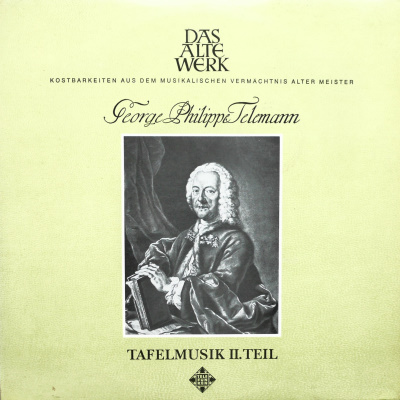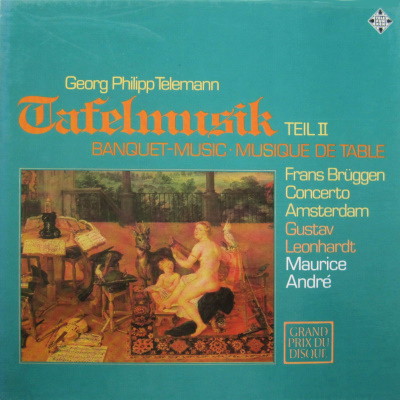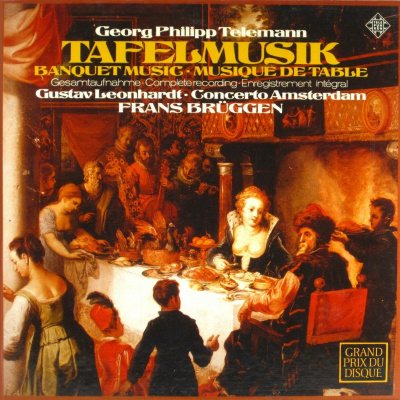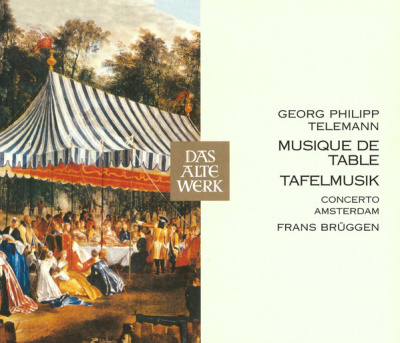 |
|
2 LPs
- SAWT 9451/52-A - (p) 1965
|
 |
| 2 LPs -
6.35060 DX (TK 11548/1-2) - (p) 1974 |
 |
| 6 LPs -
6.35298 FX - (p) 1976 |
 |
| 4 CDs -
0825646945726 - (c) 2014 |
|
TAFELMUSIK,
II. Teil
"Musique de Table partagée en Trois
Productions dont chacune contient I
Ouverture aver la suite à 7 instruments,
I Quatuor, I Concert à 7, I Trio, I
Solo, I Conclusion à 7 et dont les
instruments se diversifient par tout;
composée par Georg Philipp Teleman,
Maître de Chapelle de Lrs, As, Ss, le
Duc de Saxe.Eisenach, et le Marggrave de
Bayreuth; Directeur de la Musique à
Hambourg."
Originaltitel nach der
kupferstichausgabe von 1733.
|
|
|
|
|
|
|
|
| Georg Philipp
TELEMANN (1681-1767) |
Ouverture
D-dur - für Oboe, Trompete in D,
Streicher und Basso continuo |
|
25' 14" |
|
|
-
Lentement · Vite · Lentement
|
7' 00" |
|
A1
|
|
- Air I (Tempo giusto)
|
6' 14" |
|
A2
|
|
- Air
II (Vivace)
|
2' 42" |
|
A3 |
|
- Air
III (Presto)
|
5' 42" |
|
A4
|
|
- Air
IV (Allegro)
|
3' 36" |
|
A5 |
|
Quartett
d-moll - für zwei Querflöten,
Blockflöte und Basso continuo |
|
16' 27" |
|
|
-
Andante
|
3' 30" |
|
B1 |
|
-
Vivace |
3' 55" |
|
B2 |
|
-
Largo |
3' 37" |
|
B3 |
|
-
Allegro |
5' 05" |
|
B4 |
|
Konzert
F-dur - für drei Violinen, Streicher
(dreistimmig) und Basso continuo |
|
14' 12" |
|
|
-
Allegro |
5' 47" |
|
C1 |
|
-
Largo |
5' 28" |
|
C2 |
|
-
Vivace |
2' 57" |
|
C3 |
|
Trio
e-moll - für Querflöte, Oboe und
Basso continuo |
|
13' 10" |
|
|
-
Affettuoso |
3' 07" |
|
C4 |
|
-
Allegro |
3' 00" |
|
C5 |
|
-
Dolce |
3' 04" |
|
D1 |
|
-
Vivace |
3' 59" |
|
D2 |
|
Solo
A-dur - für Violine und Basso
continuo |
|
11' 08" |
|
|
-
Andante |
2' 09" |
|
D3 |
|
-
Vivace |
2' 38" |
|
D4 |
|
-
Cantabile |
3' 05" |
|
D5 |
|
-
Allegro · Adagio · Allegro |
3' 16" |
|
D6 |
|
Conclusion
D-dur - für Oboe, Trompete in D,
Streicher und Basso continuo |
|
6' 40" |
|
|
-
Allegro
|
2' 39" |
|
D7 |
|
-
Adagio |
1' 15" |
|
D8 |
|
-
Allegro |
2' 46" |
|
D9 |
|
|
|
|
|
CONCERTO AMSTERDAM |
Frans
BRÜGGEN, Leitung
- Jaap Schröder, Konzertmeister
- Gustav Leonhardt, Cembalo
Solisten:
Ad Mater,
Oboe
Maurice André, Trompete
Frans Vester, Joost Tromp, Querflöte
Frans Brüggen, Blockflöte
Jaap Schröder, Jacques Holtman,
Marie Leonhardt, Violine
Anner Bylsma, Violoncello
Brian Pollard, Fagott
Veronika Hampe, Gambe
Eugen M. Dombois, Theorbe
[Laute] |
|
|
|
|
|
Luogo
e data di registrazione |
|
Huize Queekhoven,
Breukelen & Hervormde Kerk,
Bennebroek (The Netherland) -
Febbraio, Settembre, Ottobre e
Dicembre 1964
|
|
|
Registrazione:
live / studio |
|
studio |
|
|
Producer |
|
Wolf Erichson
|
|
|
Prima Edizione
LP |
|
Telefunken "Das Alte
Werk" | SAWT 9451/52-A | 2 LPs -
durata 41' 41" - 45' 10" | (p)
1965 | ANA
Telefunken
| 6.35060 DX (TK 11548/1-2 | 2
LPs - durata 41' 41" - 45' 10" |
(p) 1974 | ANA | Riedizione
Telefunken |
6.35298 FX | 6 LPs - durata 252'
55" | (p) 1976 | ANA |
Riedizione (Produzioni I-II-III)
|
|
|
Edizione CD |
|
Warner Classics |
LC 06019 | 0825646945726 | 4 CDs
- durata 252' 55" | (c) 2014 |
ADD | (Produzioni I-II-III) |
|
|
Cover
|
|
Georg Philipp
Telemann von Valentin Daniel
Preisler nach dem Gemälde von
Ludwig Michael Schneider.
|
|
|
Note |
|
-
|
|
|
|
|
In der second
"Production" of his "Musique
de Table", as also in the
other two parts, Telemann
has made extensive use of
his universal symthesis of
styles and forms and, in
accordance with his
aesthetic creed and the
obligation laid upon him by
society and his own fame
always to seek - and to have
to seek - something new, he
deliberately and
imaginatively modified the
second "Production" in
comparison with the other
two parts of the work. This
is manifested most of all in
the orchestration: Overture
and Conclusion employ the
oboe and the trumpet as
'concertante' solo
instruments in addition to
the four-part string
orchestra, the Quartet and
Trio also give preference to
wind instruments (recorder,
flutes and oboe), and only
the Concerto (for there
violins) and the Solo Sonata
(for violin and continuo)
are written for strings
only.
The D major Overture begins
with the traditional festive
Lentement of the French
Overture in dotted rhythms
and rolling runs, but
inserts a surprising little
episode with rustically
swaying parallel sixths and
thirds over sustained
chords. (Handel, the only
English subscriber to the
"Musique de Table", let
himself be inspired by this
introduction, and used its
two contrasted sections in
the final chorus of the
first act of "Hercules" in
1744.) The Allegro that
follows ("Vite") begins in
the traditional fugato
manner, but soon introduces
typically "Telemannic"
rhythmic jokes, triplets and
spicy symcopations which
give the movement almost the
character of hunting music.
The firther sequance of
movements is hardly in the
fugato French style any
more, but rather in the
'concertante' Italian style
with big solos for the oboe
and first violin and
frequent parallel thirds
between the oboe and the
trumpet. The latter is used
here - characteristically
for Telemann - not so much
with "heroic" motifs as in
true 'cantabile' style. The
movement is rounded off with
a varied repetition of the
introduction. There now
follow four "Airs" in which
traditional dance-movement
characters of the French
Overture and movement forms
of the Italian concerto
mingle with each other in
highly "modern" fashion; a
large-scale, energetic
quasi-Allemande with
extensive solos for oboe,
trumpet and first violin
(arranged by Handel as the
second movement of his Organ
Concerto Op. 7 No. 4), a
somewhat briefer and less
extravagant Minuet in 3/8
time, a Bourrée, again with
large-scale, completely
"concertante" solos and
finally a quasi-Gigue which
combines the hunting of the
first movement with the
exuberant gaiety of the
Bourrée.
The Quartet in D minor is
for two flutes, recorder and
continuo; instead of the
recorder the bassoon or the
cello may be chosen
alternatively, the part
being written in the French
treble clef (g' on the
lowest line) so that it many
easily be read as bass clef,
an octave lower - a
technique which Telemann
obviously borrowed from the
French chamber music of his
time. In spite of all the
earnestness of expression
and all the chamber music
strictness and finesse of
structure, the tendency to
mix various spheres of style
is again evident here. The
sequence of movements of the
baroque Sonata da chiesa is
retained (slow - quick -
slow - quick), but its
polyphonic strictness is
relaxed to 'concertante'
playing, in places almost to
thematic working out in the
sense of the classical era,
with little "speaking"
motifs. The quick movements,
with their extensive solo
passages, show concerto-like
features, and the finale
with its rapturous A major
middle section full of
thirds is a little
"concerto" in three sections
in itself.
This work is followed by a
genuine Italian concerto
that forms the centrepiece
of the "Production" - a
three-movement Concerto in F
major (thus in the relative
major of the D minor
Quartet), for three violins
and three-part string
orchestra. In its outer
movements this work develops
a real virtuoso brilliance,
especially in the broadly
conceived and sonorous
opening Allegro, while the
Largo revels in Telemannian
melodiousness, in parallel
thirds and sixths of the
solo violins over sustained
chords and in genuine
pastoral melody.
The delicate sensitivity of
this movements is
transformed into the fine,
intimate quality of chamber
music in the Trio Sonata in
E minor for flute, oboe and
continuo, above all in the
introductory affettuoso,
whose motifs at first appear
in dialogue form but are
then presented
simultaneously with great
artistry in the second
section. The second movement
is lighter in its thematic
material and more relaxed in
its structure, developing
alternately in 'concertante'
style or in thise parallel
thirds and sixths and
anapaest rhythms which play
such a prominent role in
this entire "Production". A
blending of the spirit of
the suite and that of the
sonata is then aimed at in
the sensitive, elegiac Dolce
in A major and the humorous
Vivace finale. With its
combination of sensitive,
"sighing" melody and
predeliction for thirds and
sixths with the pointed
humour of its composition
and its "speaking" dialogues
in which the two wind
instruments alternate with
one another over a continuo
bass mostly thematically
free, only providing
harmonicsupport, this Trio
Sonata is probably the most
"modern" of its time and, in
its wealth of expressive
nuances and thematic and
structural ideas, perhaps
the most important work of
this "Production".
As in the First Part of the
"Musique de Table", the solo
sonata - here a Violin
Sonata in A major - seems
less demanding and more
conventional, although it
attains concerto-like
virtuosity in the second
movement and develops,
partocularly in the quick
movements, the
polonaise-like Vivace and
the final Gigue, typical
Telemannian rhythms with
their "snappy" iambic and
anapaestic formulae with
magnificent verve. Finally,
the Conclusion links up with
the Overture in its key and
its instrumentation,
demonstrating the main
purpose of the entire
"Musique de Table" - the
synthesis of all styles and
forms of instrumental music
of that time. This is done
programmatically as it were,
by blending concerto-like
'dacapo' form with a
dignified Adagio middle
section, concerto movement
form (with symmetrically
ordered solo passages framed
and separated by a
ritornello) and fugal
principle (the ritornello is
laid out as a fugal
exposition) into a
magnificently energetic,
colourful and virtuoso
"final dance".
Ludwig
Finscher
|
  |
|
|